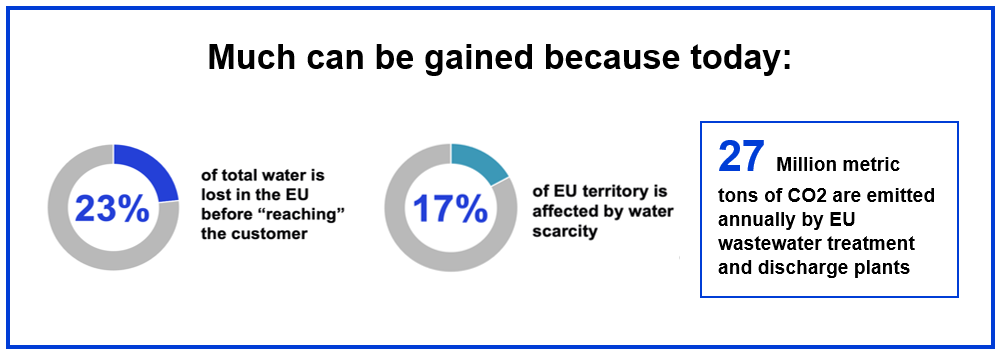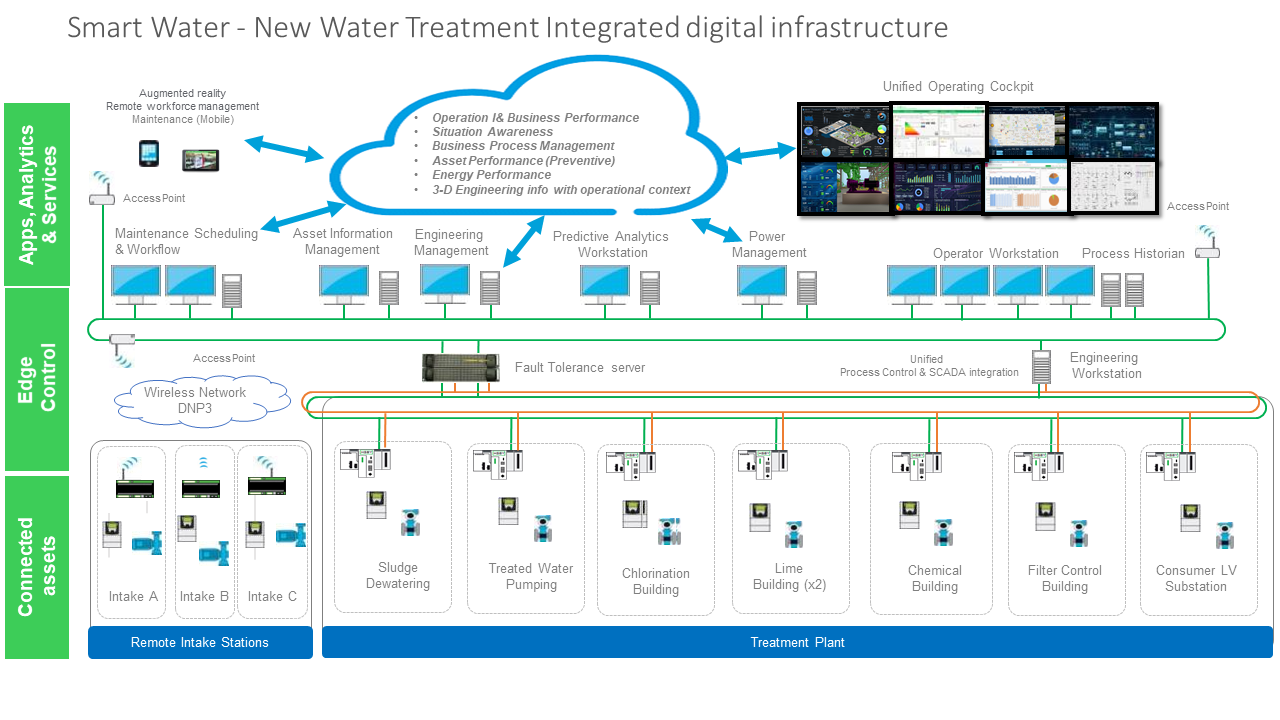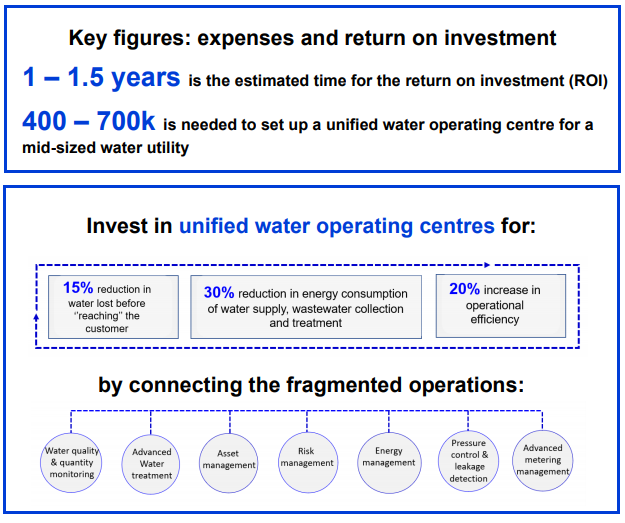Upgrading water management: how to turn digital investment into real sustainability gains

Executive Summary
The EU Green Deal Strategy defined tackling climate and environmental-related challenges as ‘’this generation’s defining task’’.[1] Digital remains the single most important tool to deliver substantial environmental gains through increased efficiencies. This paper uses water utilities as just one example which accounts for:
- 5% of the EU’s electricity consumption
- 30-50% of local authority’s electricity consumption.[2]
- water produced and “lost” before reaching the customer is on average 23% of total net water produced in the EU.[3]
DIGITALEUROPE encourages Member States to use the EU Recovery and Resilience Facility (RRF) as a once in a generation public investment to deliver grants and loans for the digitalisation of industries and the public sector to deliver performance, leadership and compliance with existing requirements.
In some Member States, in 2017 it was estimated governments would have to invest more than €6 billion by the end of 2020 to cover their water needs.[4] Leveraging digital technologies for the creation of unified water operating centres across Member States can help us to protect our most precious resource today, water, while streamlining utilities’ operational efficiency and reducing their carbon footprint. The Return on Investment (ROI) for upfront RRF investments in the range of 400-700 thousand euro for a mid-sized water utility is 1-1.5 years.
Studies highlighted digital technologies delivered about € 300 billion in capital and operating expenditure savings to the global water industry in 2016-2020, targeting water segments such as treatment of wastewater and treatment, distribution, customer management and metering of drinking water.[5]
Beyond water, DIGITALEUROPE has produced over 35 examples across many areas, from education to healthcare, SMEs, municipalities, transport and others, where digital will deliver reductions in waste, energy and greenhouse gas emissions while boosting growth and jobs.
In this publication we quantify the investment needs and value of digital solutions for the water sector’s sustainability goals. We describe why it is in the interest of Member States to prioritise RRF funding for the creation of unified digital platforms for smart water operations.
2. Water stress and scarcity is on the rise
Water utilities have a key role in building a sustainable future for Europe’s economy and society.
The European Commission acknowledged how ‘’in some areas, [water] availability is limited and the existing sources are under significant stress”.[6] Satisfying this growing demand for such a precious, yet scarce, resource will be the main challenge for Europe’s decision-makers in the next decade. Ensuring safe and clean water and sanitation is critical for human health, the environment and economic development. Managing it properly is key for resilience to climate change.
In the past 50 years, across Europe water demand has continuously increased on the back of steadily growing population. The amount of renewable water resources per capita has already dropped by 24 %[7] and water scarcity affects 17% of the EU.[8] About 40-60% of water is lost globally in terms of non-revenue water (NRW), an indicator for water that has been produced and “lost” before it reaches the customer. In the EU, the average water losses are 23% of total water.[9]
Crucially, water challenges spill over into energy consumption challenges. Studies show that the net annual electricity consumption for urban water management is 5.5% of the total amount of electricity consumed by households in just one year in Europe.[10] This water-energy nexus has a direct impact on Europe’s CO2 emissions. To this end, both fresh- and wastewater management are in need of an upgrade, but the biggest gains can be made in wastewater management. In 2019 alone, EU wastewater treatment and discharge plants emitted 27 million metric tons of CO2 in the atmosphere.[11] Urgent action is needed to make Europe’s water sector more sustainable in the future.
3. Why digital matters for water utilities
Under EU water legislation, municipalities and water utilities are required to reduce their CO2 footprint and improve water conservation. Digital technologies offer hardware, software and equipment infrastructure to enable more connected, intelligent, efficient and responsive water systems and services. All this translates into concrete benefits for water utilities. Direct savings can be identified in the areas of labour cost, chemical use, energy efficiency, reduction in downtime, leakage, NRW reduction, network optimisation, flood prevention and mitigation, demand control, billing efficiency and capital expenditure (CAPEX). But there are important indirect savings too, like improvements in environmental quality, public health, improved customer experience and communication.
Two large segments of the water sector, addressing leakage and infrastructure, stand out as clear cases for urgent digital investments through the RRF.
3.1. Improving water conservation
Leakage is a critical issue in water conservation. A 5% decrease in water distribution system leakage would save 1 million m3 per day of water and 313 million kilowatt-hours of electricity annually. This is equal to the electricity usage of over 31,000 homes. It would also avoid the emission of approximately 225,000 metric tons of CO2.
Analysts demonstrated that digital technologies can reduce leakage by up to 38% with a reactive or passive leakage control and a more proactive energy-saving strategy in water systems. Similarly, digital delivers a better preventative maintenance of sewerage systems, which can decrease infiltration and inflow in sewers by up to 68%. Water from infiltration is considered to account for up to 40% of all flow in sewers of good or average condition, and almost 100% in those of poor condition.[12]
- A Water and Sewer Department in the US resorted to IoT, a cloud database, and thousands of sensors gathering water pressure, flow rates and rainfall data to build a dataset of 15 billion rows of historical data to address water leakage and better serve over 400,000 households.
The EU can also achieve significant reductions in water and energy use, while saving costs, through water reuse. These are examples of how these savings come about:
- An average sized 1,000 megawatt hour power plant that installs a water reuse system for cooling tower blow-down recovery would decrease the energy demand to produce, distribute and treat water by a net 15%, or enough to power over 350 homes for a year.[13]
- A US factory in the food industry deployed advanced cooling water system control technology to reach savings of 2.3 billion gallons of water (equivalent to 8.7 million cubic meters) per year. [14] This is equivalent to the annual drinking water needs of almost 8 million people, or the population of an average-sized EU country.
- A firm in the automotive sector used digitally connected solution for cooling tower performance optimization and water use reduction to reduce water consumption per vehicle by 30%. The estimated cost savings are above 150 thousand Euro annually.
3.2. Bolstering infrastructure resilience
The second key segment is about infrastructure. Water utilities will face growing operational continuity challenges due to ageing systems and workforce changes. These factors will put more emphasis on the efficiency and resilience of utilities’ operations. COVID-19 challenged the continuity of service to react quickly to shifting conditions. It soon taught that resilience cannot be built over a fortnight.
All this urges for profound infrastructure renovations pivoting to digital. Tuning and optimisation across the wastewater segment of the industry can dramatically boost efficiency and thus cut total GHG emissions in the water sector. [15] In municipalities, existing technology makes it feasible today to cut substantially the energy use of the wastewater treatment facilities. Some have already leveraged this opportunity at scale. In Denmark, the entire water cycle of Aarhus’s wastewater treatment plant turned energy-neutral thanks to big digitalisation investments. Carbon footprint was also cut down by 35% through the installation of sensors, new variable speed drives and advanced process controls.[16] Additionally, water quality is to benefit from better water infrastructure. Tightening water quality standards induce water operators to resort to digital to be compliant with regulations and keep costs at bay.
Overall estimates put the productivity boost of digital technologies at 5-10% of overall revenue by 2025.[17] The emergence of new water technology has brought about a new age where performance of water services must be seen through the lenses of both sustainability and efficiency. Digital can make this co-existence work. It can, too, spur the growth of water management business opportunities for the local value chain.
4. A unified water operating centre as recommended investment
We urgently recommend Member States to prioritise water digitalisation investments in the RRF. Digitally transforming water infrastructure is key for sustainability. EU governments can achieve it by earmarking funding for unified water operating centres that bring together in a single set-up various smart water operations.
4.1. Capital expenditures (CAPEX) and Operational expenditures (OPEX) of the investment
The investment for a unified water operating centre varies according to the size of the water utility and the number of citizens it serves. Typically, it ranges from 150-300 K euro for a small infrastructure to more than 1.500 K euro for a large infrastructure. Experience also shows the payback on those investments is quick.

These estimates do not include the OPEX of the investment, which is mainly relevant for smart water applications and control centres. We believe OPEX would represent a yearly recurrent expense out of the initial CAPEX figures presented.
Instead, the estimates do include the installation of critical smart water artificial intelligence software that improves efficiency and sustainability, either through advices for the operator or by automatically adjusting the water process, under human oversight. [18] This software helps to strengthen the unique capabilities of the unified operating centre, spanning from the local and remote monitoring of a single site to monitoring multiple sites simultaneously, as is needed in EU large cities. Only 40% of cities over 150 000 inhabitants in the EU have climate change adaption plans based on sustainable models.[19] Unified water operations must play a key role to boost this figure.
Running water operations through the unified centre relies on a mix of cloud technologies, including private cloud, public cloud and edge computing, where data processing happens close to the data source. The specific configuration chosen varies according to the preferences of the water utility.
Yet all different set-ups confirm how cloud technology should become the default option to process an ever-growing amount of water-related data. It offers high-computing and storage capabilities, as well as access to large public applications like weather forecast and remote usage (workforce management). The introduction of cloud solutions and cloud-based business applications[20] in water digitalisation has brought balance between CAPEX and OPEX in investment projects. This helps to explain why unified water operating centre investments generate ROI in 1-1.5 years’ time, even for large multi-site water utilities. This is a crucial peculiarity of such investments that sits well with the Commission’s vision for national RRF plans that are to re-launch our economy.[21]
4.2. KPIs from the investment
A unified operating centre can help a water utility to integrate and contextualise several types of data from various field infrastructures and different systems. These include instrumentation, sensors, power metering, telemetry & SCADA, Geographic Information System (GIS), simulation models, workflow, leakage management, management or customer information system.[22] The data collected in the platform is then used to provide operational insights and make smart decisions.

We quantified the benefits of a unified water operating centre for a water utility in seven water application areas. Overall, we estimate they add up to a 15% reduction in water lost before ‘’reaching’’ the customer, 30% energy savings and renewable management, 20% operational efficiency improvement through faster detection of issues and subsequent intervention.
Here is the breakdown per area:
Water quality and quantity monitoring
Real-time supervision of the condition of the water supplied through the distribution network and the status of the sewer system allows for faster detection of anomalies in flow, pressure or water quality and faulty equipment. It enables compliance with regulation, an adequate level of service, and operational improvement through remote operation and control of the wet infrastructure which we estimate to be up to 20%.
Advanced water treatment
Plant automation and optimization integrating energy and process data provides significant savings in:
- energy consumption
- operation efficiency up to 10%
- production efficiency up to 20% of total cost of production
Crucially, it is not just the public actor to benefit from advanced process control and digital technologies for water treatment. These digital tools also help the water industry, which consumes more water than any other sector besides agriculture, to comply with zero liquid discharge requirements.[23] In addition, digital platforms can tangibly reduce inlet water needs by as much as 20-30%. They offer a significant step forward in water recycling through better water use.
Asset management
Condition-based asset management using sensors and analytics for asset health monitoring and predictive maintenance brings multiple advantages:
- optimisation of system availability reducing downtime
- extension of the life of assets saving capital expenditure and operational expenditure (up to 15%) together with an improvement of operational efficiency.
- improvement of labour utilisation rate by 20% and reduction of maintenance costs by 30% when integrated with an enterprise asset management system to automate maintenance operations.
Risk management
Safety and security automation solution to improve the safety of the process and of the people.
The rising usage of the new technology like IOT and Cloud are potentially generating new risks for the critical infrastructures. Therefore, a Cybersecurity policy based on rules, technologies and services should be implemented in the water, waste water infrastructures to make them resilient and safe.
Additionally, flood risk management for flood forecast, flood management and action prioritization.
Energy management
Power monitoring system, presenting dashboards and KPIs on energy managements for the different sites across the water utility with contextualised energy and processes data. It provides energy savings up to 8%, improves response to power-related issues, reduces total cost of ownership and improves operational safety of power equipment thanks to power quality monitoring.
Pressure control and leakage detection
A system for holistic leak management strategy. It gathers data from different systems (telemetry/SCADA, customer information system, GIS, hydraulic model, CMMS, other) and uses it to detect leaks in the water distribution network. It then manages the inspection and repair works, following the entire leak life cycle. Active pressure management serves the purpose of controlling the pressure in the network to reduce both water loss amount and stress in the pipes, thus preventing pipe bursts.
This solution allows to:
- reduce water loss levels by up to 10%, which is equivalent to 6 Mm3/year of water saved in one case study and 4,97 m3/km/day achieved in another case study.
- curb energy consumption up to 15% and cut the amount of chemicals used for water treatment.
- increase operational efficiency by 10% thanks to shortening detection and intervention times
- achieve capital expenditure savings by prolonging the life of pipes through reduction in burst and therefore less pipe replacement.
Advanced metering management
With advanced metering infrastructure (AMI), water utilities can dramatically streamline their meter-to-cash operations while simultaneously enhancing customer service. AMI also provides a dramatic increase in data availability, which is useful for managing NRW, conservation programs, distribution system operation, capital-planning as well as rate-setting. It could lay the foundations for new business models in the energy sector to support the migration to demand side management. All this is critical to realise smart city sustainability and efficiency goals.
Additional benefits provided by integrated smart operations solution
It offers a single view of assets and systems across the utility by the integration of IT/OT. This gives the ability to provide consolidated and contextualized insight on the whole enterprise performance for decision support. It enables an integrated approach unifying sites, people, process, assets and technology for a more efficient and effective use of water, energy and assets. Its advantages lie in a centralised control of the infrastructure, optimised operations and workforce empowerment through collaboration, training and knowledge-sharing.
Annex – Main technologies for water digitalisation[24]
- SCADA: it stands for Supervisory, Control and Data Acquisition system. SCADA is a combination of software and hardware that receives operating (real-time) data about a process and associated equipment. This data is then used to control and optimise that process. SCADA systems can be installed in a single facility or be spread across a wide geographical area thanks to various communication methodologies, such as telemetry. A SCADA system includes:
-
- remote terminal units
- programmable controllers
- communication infrastructure and human-machine interface (HMI).
These systems are widely employed to offer supervision, control and data management over water and wastewater plants and networks, and river basins.
- Smart water artificial intelligence (AI) software: This is based on simulation models such as hydraulic, hydrologic and water quality models. It is widely used in water utilities for:
- Simulation models: hydraulic, hydrologic and water quality models are well known and widely used at water utilities, traditionally for planning purposes, now more and more for real-time operation and optimisation. Simulation models are also used for APC to optimise the efficiency and energy consumption of the process. Water and wastewater-specific algorithms provide inferences about aspects like chemicals, chlorination filtration control, water quality and energy saving.
-
- asset performance management: a new generation of AI software provides condition monitoring services on critical assets like pumps and membranes, thereby helping to maintain the reliability of those systems.
-
- leakage management: this suite of AI software leverages real-time information from meters, field devices and historic data (SCADA data) to facilitate rapid water leak detection. Crucially, an end-to-end leakage management system not only detects leaks, but also follows the leak lifecycle during inspection and repair activities.
- Unified water operating system: it is a data-gathering and computing system associated to a Human Machine Interface (HMI). It connects multiple applications from several sources. Many such systems are nowadays cloud-based. The most essential among these process data from the different SCADA systems installed in the plant. However, more and more unified operating systems are today leveraging data originating also from other, very diverse applications hosted in the cloud as well. Examples of these applications are:
-
- Water resources management: it is about the use of Geographic Information System (GIS), which is a framework to gather and analyse spatial and geographic data. It is a spatial platform to store, geo-reference and geo-process information, afterwards presented as maps. It is relevant for weather forecast systems to have a proactive management of the water resources, or for water usage when it comes to soil irrigation.
-
- Workforce management: it helps to streamline routine business and develop virtual training, enable artificial intelligence for on-site support to boost work efficiency and productivity, as well as reduce non-compliance risks and human error.
-
- Business applications
-
-
- Computerized Maintenance Management System (CMMS): it is a software package that maintains a computer database of information about an organisation’s maintenance operations. It covers data ranging from spares and purchasing activities to inventory management and maintenance operations.
-
-
-
- Customer Information System (CIS): it is a software package addressing meter-to-cash flow process and customer services
-
Both CMMS and CIS are cloud-enabled. Artificial intelligence helps to translate data they store into easy-to-understand operation insights for various roles in the organisation.
REFERENCES
[2] Euractiv, How Europe can make its water sector energy neutral, 2018
[3] EAUSE, Energy-water nexus: accelerating energy savings for the clean energy transition, 2019
[4] European Court of Auditors, Special Report: Implementing the Drinking Water Directive: water quality and access to it improved in Bulgaria, Hungary and Romania, but investment needs remain substantial, 2017
[6] European Commission, EU Progress on Resource Efficiency and Green Economy – Technical Report, 2020
[7] European Environmental Agency (EEA), Water use in Europe — Quantity and quality face big challenges, 2018
[8] European Commission, Water Scarcity and Drought in the European Union, 2010
[9] EAUSE, Energy-water nexus: accelerating energy savings for the clean energy transition, 2019
[10] About 80% of this amount is for energy use for drinking water suppliers being pumping. Source: US Congressional Research Service, Energy-Water Nexus: The Water Sector’s Energy Use, 2017
[11] Figures come from the European Environmental Agency (EAA). More info here
[12] Global Water Research Coalition, Energy Efficiency in the Water Industry: A Compendium of Best Practices and Case Studies – Global Report, 2010
[13] Energy-water Nexus: Hearing Before the Committee on Energy and Natural Resources, United States Senate, 2009
[14] Ecolab, Helping ADM Save 2.3 Billion Gallons of Water, 2020
[15] The Chartered Institution of Water and Environmental Management (CIWEM), A Blueprint for Carbon Emissions Reduction in the UK Water Industry, 2013
[16]EAUSE, Energy-water nexus: accelerating energy savings for the clean energy transition, 2019
[17] Frost & Sullivan, The Future of Water and Resource Recovery Markets, 2020
[18] These estimates also assume the water utility is already equipped with a SCADA system. SCADA is an acronym for supervisory control and data acquisition. It gathers and analyses real- time data from water assets and water process. Were the utility not already have SCADA in place, decision-makers should add 50-100 K for a small utility, 2000-3000 K for a mid-sized utility and 5000 K for a large utility. We estimate SCADA investments for water utilities, mainly about hardware for connectivity and automation, to generate ROI in less than 3 years.
[19] European Commission, The role of smart cities in meeting the objectives of the Green Deal, 2020
[20] So-called Software-as-a-Service (SaaS)
[21] European Commission Staff Working Document, Guidance to Member States: Recovery and Resilience Plans, 2020, p. 4
[22] See Annex I for a more detailed illustration of these technologies
[23] Zero liquid discharge includes a series of processes like filtration and reverse osmosis that extract pure water from industrial effluents. The Industrial Emissions Directive (2010/75/EU) is a key example of zero liquid discharge requirements at EU level.
[24] Another integrated approach is the “digital twin” concept. This is a comprehensive digitalisation and automation solution. All physical water plant components are captured with software using photogrammetry and compiled into a 3D model. The model data is linked with a control system to create a complete digital twin that comprises all the engineering and operation data of the plant across its entire lifecycle.



